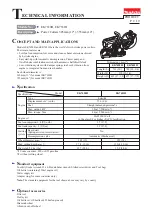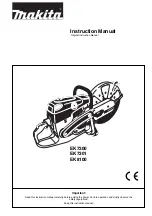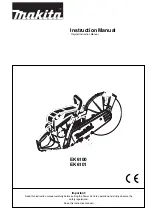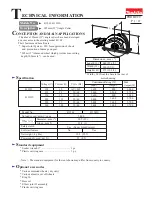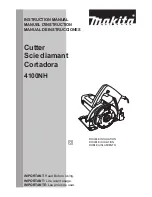
9 – English
MAINTENANCE
LUBRICATION
Frequent, but not excessive, lubrication is required for
best performance. Oil for pneumatic fastening tools added
through the air line connection will lubricate the internal parts.
Do not use detergent oil or additives as these lubricants will
cause accelerated wear to the seals and bumpers in the
tool, resulting in poor tool performance and frequent tool
maintenance.
COLD WEATHER OPERATION
For cold weather operation, near and below freezing, the
moisture in the air line may freeze and prevent tool operation.
We recommend the use of air tool lubricant or permanent
antifreeze (ethylene glycol) as a cold weather lubricant.
CAUTION:
Do not store tools in a cold weather environment
to prevent frost or ice formation on the tools’
operating valves and mechanisms that could cause
tool failure.
NOTE:
Some commercial air line drying liquids are harmful
to “O” rings and seals. Do not use these low temperature
air dryers without checking compatibility.
AIR SUPPLY PRESSURE AND VOLUME
Air volume is as important as air pressure. The air volume
supplied to the tool may be inadequate because of undersize
fittings and hoses, or from the effects of dirt and water in the
system. Restricted air flow will prevent the tool from receiving
an adequate volume of air, even though the pressure reading
is high. The results will be a slow operation or reduced
driving power. Before evaluating tool problems for these
symptoms, trace the air supply from the tool to the supply
source for restrictive connectors, low points containing
water and anything else that would prevent full volume flow
of air to the tool.
WARNING:
When servicing use only identical replacement
parts. Use of any other parts could create a hazard
or cause product damage.
WARNING:
Always wear eye protection with side shields
marked to comply with ANSI Z87.1. Failure to do
so could result in objects being thrown into your
eyes resulting in possible serious injury.
WARNING:
Disconnect the tool from the air supply before
performing maintenance. Failure to do so could
result in serious personal injury.
GENERAL MAINTENANCE
Avoid using solvents when cleaning plastic parts. Most
plastics are susceptible to damage from various types of
commercial solvents and may be damaged by their use. Use
clean cloths to remove dirt, dust, oil, grease, etc.
WARNING:
Do not at any time let brake fluids, gasoline,
petroleum-based products, penetrating oils, etc.,
come in contact with plastic parts. Chemicals can
damage, weaken or destroy plastic which could
result in serious personal injury.
OPERATION
WARNING:
The tip of the roofing cutter blade is sharp. Do
not touch the blade or allow it to come in contact
with anything other than the material being cut.
Failure to heed this warning could result in serious
personal injury.
If desired, snap a chalk line on the material to be cut to
show the planned cut.
Connect the tool to the air supply.
Press the trigger lock lever forward and depress the
trigger to start blade movement.
Place the tip of the blade underneath the material to be
cut so that the cutting area of the blade aligns with the
desired line of cut. Draw the cutter toward you to cut the
material.
NOTE:
Do not force. Use only enough pressure to keep
the tool cutting. Let the blade and tool do the work. Use
of excessive pressure that causes bending or twisting of
the blade may result in broken blades.
When finished, release the trigger to allow blade to stop.


























